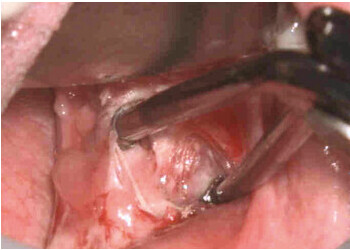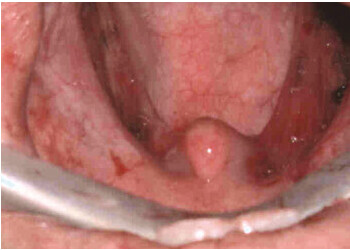To-BiTE non-stick Bipolar Clamp
Bipolar tonsillectomy using To-BiTE non-stick bipolar clamp
The To-BiTE non-stick bipolar clamp is an ideal instrument for bipolar tonsillectomy. The bipolar clamp can be used for all blunt and cold dissection techniques; it features bipolar coagulation and suction. Four functions are combined in one instrument enabling the surgeon to coagulate, grasp, dissect, and extract fumes or blood with the use of only one instrument.
Advantages
The To-BiTE non-stick bipolar clamp was developed to help surgeons perform tonsillectomies with bipolar forceps for both coagulation and dissection. As it is advantageous to combine blunt dissection and simultaneous bipolar coagulation of vessels when they become accessible during dissection, the method has become widely accepted and used. It is possible to apply very little coagulation and to use it only when necessary. This technique helps to reduce postoperative pain. As the vessels are sealed immediately during dissection, even before they retract into the muscle tissue, this technique makes the tonsillectomy procedure very clean because perioperative bleeding is almost eliminated. Once the tonsil is removed, the tonsillar bed does not need to be coagulated: By then all vessels have already been closed. The combination of pressure on vessel walls with bipolar coagulation results in a superbly safe seal, which can significantly reduce postoperative bleeding.
(see abstracts in our media center)
Conventional bipolar forceps, which are used for this surgical technique, can only be used for grasping and pulling. The classic blunt dissection with scissors-like outward movements is not possible with conventional bipolar forceps. Moreover, most conventional forceps do not feature a suction channel to evacuate saliva, blood or smoke. To compensate this disadvantage, surgeons either need a “third hand” or they have to constantly change between different instruments. This is the major advantage of the To-BiTE non-stick bipolar clamp: It is an ideal instrument for bipolar tonsillectomy. The bipolar clamp can be used for all blunt and cold dissection techniques and it features bipolar coagulation and suction. The To-BiTE non-stick bipolar clamp makes it possible to perform bipolar tonsillectomies with just one instrument throughout the procedure and without a “third hand”.
Tonsillectomy using To-BiTE non-stick bipolar clamp


Application video
FAQ
What is the most efficient way of using the To-BiTE non-stick bipolar clamp?
Grasp the tonsil with a tonsil clamp, and draw in median direction. This facilitates the opening up of connective tissue by coagulation and the placing of the instrument. While keeping a tight draw, dissect the tonsil gradually by "plucking" the tissue away. Coagulate bleeding vessels right away and extract blood by suction. Experience has shown that it is best to start dissection at the inferior pole to be able to close off the larger vessels faster.
Do I have to coagulate constantly while dissecting with the To-BiTE non-stick bipolar clamp?
No, the coagulation current is only being activated when dissecting connective tissue and for systematic hemostasis.
Do you recommend the use of other accessories or units?
We recommend magnifying the surgeon's field of vision. Best suited for this purpose are loup lenses (magnification 3.5 times, distance approx. 30 cm). These offer sufficient magnification and plenty of freedom of movement. A microscope is also suitable. Thanks to the magnification, vessels can be identified more easily and bleedings sealed more efficiently, or vessels can also be sealed before section.
Do I need to connect the To-BiTE non-stick bipolar clamp to a special suction device?
No, you can use the To-BiTE with the suction apparatus available in your OR.
Further information
For detailed information on applications and accessories, please refer to our product flyer:
To-BiTE non-stick Bipolar Clamp (DE/EN)
[384 kb]
Instructions for use:
GAW To-BiTE non-stick Bipolar Clamp [1,7 MB]

; height: auto; },
(min-width: 501px) { src: url(https://www.sutter-med.de/chameleon/mediapool/thumbs/a/00/To-BiTE-non-stick-Bipolar-clamp-Banner-02_800x352-ID5164-4253c282de13ecdbfecd28889aaf83e9.jpg); height: auto; },
(min-width: 801px) { src: url(https://www.sutter-med.de/chameleon/mediapool/thumbs/a/00/To-BiTE-non-stick-Bipolar-clamp-Banner-02_1800x792-ID5164-45e9ac4eec24a0a0822c0973badb3a54.jpg); height: auto; }
)